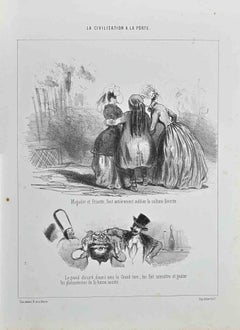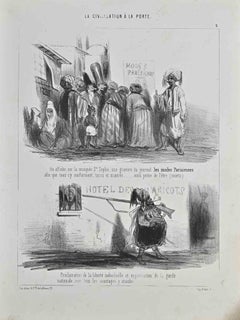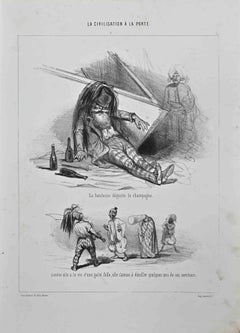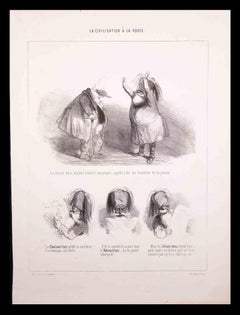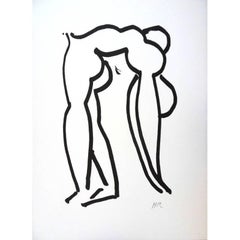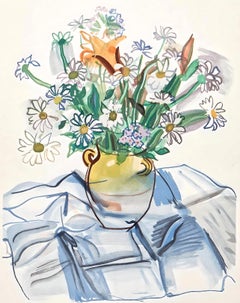Charles Amedee de Noe (CHAM) Figurative Prints
to
1
16
1
14
3
16
1
Overall Height
to
Overall Width
to
10
15
12
10
9
6
3
2
2
2
2
1
1
1
17
18
579
410
348
305
17
2
Artist: Charles Amedee de Noe (CHAM)
Civilisation à la Porte - Original Lithograph by CHAM - Mid-19th century
By Charles Amedee de Noe (CHAM)
Located in Roma, IT
Civilisation à la Porte is an Original Lithograph realized by Cham in the mid-19th century from the series "La Civilisation à la Porte".
Signed on the plate by the artist on the low...
Category
19th Century Modern Charles Amedee de Noe (CHAM) Figurative Prints
Materials
Lithograph
Civilisation à la Porte - Original Lithograph by CHAM - Mid-19th century
By Charles Amedee de Noe (CHAM)
Located in Roma, IT
Civilisation à la Porte is an Original Lithograph realized by Cham in the mid-19th century from the series "La Civilisation à la Porte".
Signed on the plate by the artist on the low...
Category
19th Century Modern Charles Amedee de Noe (CHAM) Figurative Prints
Materials
Lithograph
Civilisation à la Porte - Original Lithograph by CHAM - Mid-19th century
By Charles Amedee de Noe (CHAM)
Located in Roma, IT
Civilisation à la Porte is an Original Litograph realized by Cham in mid-19th century from the series "La Civilisation à la Porte".
Signed on the plate by the artist on the lower.
...
Category
19th Century Modern Charles Amedee de Noe (CHAM) Figurative Prints
Materials
Lithograph
Civilisation à la Porte - Original Lithograph by CHAM - Mid-19th century
By Charles Amedee de Noe (CHAM)
Located in Roma, IT
Civilisation à la Porte is an Original Litograph realized by Cham in mid-19th century from the series "La Civilisation à la Porte".
Signed on the plate by the artist on the lower.
...
Category
19th Century Modern Charles Amedee de Noe (CHAM) Figurative Prints
Materials
Lithograph
Civilisation à la Porte - Original Lithograph by CHAM - Mid-19th century
By Charles Amedee de Noe (CHAM)
Located in Roma, IT
Civilisation à la Porte is an Original Lithograph realized by Cham in the mid-19th century.
Good condition, except for some foxings.
Charles Amédée de Noé , known as Cham (26 Jan...
Category
19th Century Modern Charles Amedee de Noe (CHAM) Figurative Prints
Materials
Lithograph
Civilisation à la Porte - Original Lithograph by CHAM - Mid-19th century
By Charles Amedee de Noe (CHAM)
Located in Roma, IT
Civilisation à la Porte is an Original Lithograph realized by Cham in the mid-19th century.
Good condition, except for some foxings.
Charles Amédée de Noé , known as Cham (26 Jan...
Category
19th Century Modern Charles Amedee de Noe (CHAM) Figurative Prints
Materials
Lithograph
Civilisation à la Porte - Original Lithograph by CHAM - Mid-19th century
By Charles Amedee de Noe (CHAM)
Located in Roma, IT
Civilisation à la Porte is an Original Lithograph realized by Cham in the mid-19th century.
Good condition, except for some foxings.
Charles Amédée de N...
Category
19th Century Modern Charles Amedee de Noe (CHAM) Figurative Prints
Materials
Lithograph
Civilisation à la Porte - Original Lithograph by CHAM - Mid-19th century
By Charles Amedee de Noe (CHAM)
Located in Roma, IT
Civilisation à la Porte is an Original Litograph realized by Cham in mid-19th century.
Good condition, except for some spots on the right corner.
Hand-signed by the artist on the l...
Category
19th Century Modern Charles Amedee de Noe (CHAM) Figurative Prints
Materials
Lithograph
Assemblée Nationale Comique - Vintage Rare Book Illustrated by CHAM - 1850
By Charles Amedee de Noe (CHAM)
Located in Roma, IT
Assemblée Nationale Comique is an original modern rare book illustrated by CHAM and written by Auguste Lireux (Rouen, 1814 - 1870, Bougival) in 1850.
Published by Michel Lévy Frères –Paris.
Original First Edition.
Format: large 8°.
The book includes 625 pages and 20 fully illustrated page lithographs.
Mint conditions.
Auguste Lireux (Rouen, 1814 - 1870, Bougival). Lireux began, out of college, by founding, in his hometown, a small newspaper, the Indiscret , whose sarcastic and biting tone made him many enemies and which earned him seven or eight duels, where he has almost always been injured. There he recounted the marital misadventures of his compatriots, a process which provided him with a great deal of copy, but which he had to put an end to when a chair-mender outraged in his reputation had not inflicted on him a correction which could have had very serious consequences if the painter Garneray had not come to his aid. Discouraged, in 1841 he went to Paris, where he founded La Patrie which was then regarded as an opposition newspaper. He entered several other newspapers, including the Revue et gazette des théâtres , which then had among its editors Édouard Thierry , the administrator of the Théâtre-Français, the Courrier français (1846), the Revue comique (1848), the Messenger from theaters...
Category
1850s Charles Amedee de Noe (CHAM) Figurative Prints
Materials
Paper, Lithograph
Les Folies Parisiennes - Vintage Rare Book Illustrated by CHAM - 1883
By Charles Amedee de Noe (CHAM)
Located in Roma, IT
Les Folies Parisiennes is an original modern rare book illustrated by CHAM.
Published by Calman Lévy, Paris, in 1883.
Original edition.
Format: in 4°.
3...
Category
1880s Charles Amedee de Noe (CHAM) Figurative Prints
Materials
Paper, Lithograph
America - Original Lithograph by CHAM - 19th century
By Charles Amedee de Noe (CHAM)
Located in Roma, IT
America is an original lithograph on paper realized by Charles Amédee de Noe, best known as Cham.
On the lower right corner, lith. Destouches, 28, r. Paradis.
On the lower-left cor...
Category
19th Century Modern Charles Amedee de Noe (CHAM) Figurative Prints
Materials
Lithograph
Actualités, Hiver - Original Lithograph by Cham - 1882
By Charles Amedee de Noe (CHAM)
Located in Roma, IT
Actualités, Hiver is an amusing satirical illustration by the French illustrator and caricaturist, Cham (alias Count Amédée de Noé, 1818-1879) realized in 1882.
Beautiful Hand-color...
Category
1880s Charles Amedee de Noe (CHAM) Figurative Prints
Materials
Lithograph
Actualités - Original Lithograph by Cham - 1840
By Charles Amedee de Noe (CHAM)
Located in Roma, IT
Actualités is an amusing satirical illustration by the French illustrator and caricaturist, Cham (alias Count Amédée de Noé, 1818-1879) realized in 1840.
Beautiful Hand-colored lith...
Category
Mid-19th Century Charles Amedee de Noe (CHAM) Figurative Prints
Materials
Lithograph
Actualités, Old Angle - Original Lithograph by Cham - 1865
By Charles Amedee de Noe (CHAM)
Located in Roma, IT
Actualités, Old Angle is an amusing satirical illustration by the French illustrator and caricaturist, Cham (alias Count Amédée de Noé, 1818-1879) realized in 1865.
Beautiful Hand-c...
Category
1860s Charles Amedee de Noe (CHAM) Figurative Prints
Materials
Lithograph
Silente Cinema - Original Lithograph by Cham - Mid-19th Century
By Charles Amedee de Noe (CHAM)
Located in Roma, IT
Silente Cinema is an amusing satirical illustration by the French illustrator and caricaturist, Cham (alias Count Amédée de Noé, 1818-1879).
Beautiful b/w lithograph on ivory colore...
Category
Mid-19th Century Charles Amedee de Noe (CHAM) Figurative Prints
Materials
Lithograph
Études Sociales - Original Lithograph by Cham - First Half of 1800
By Charles Amedee de Noe (CHAM)
Located in Roma, IT
Beautiful b/w lithograph on ivory colored paper.
Amusing satiric illustrations by the distinguished French draftsman and caricaturist, Cham (alias Count Amédée de Noé, 1818-1879). Plate n. 2, titled "La famille", from the series "Études sociales", Aubert, Paris.
With a smart printed captures under the image: "Mais si l...
Category
Early 19th Century Modern Charles Amedee de Noe (CHAM) Figurative Prints
Materials
Lithograph
CALIFORNIA 1850 GOLD RUSH CARICATURE
By Charles Amedee de Noe (CHAM)
Located in Santa Monica, CA
CALIFORNIA GOLD RUSH CARICATURE
Charles Amédée de Noé, aka CHAM (1819 -1879)
CROQUIS CALIFORNIENS, ca. 1850
Lithograph image inc. text 10 ½ x 6, sheet 14 x 9 1/2 inches. French...
Category
1840s Barbizon School Charles Amedee de Noe (CHAM) Figurative Prints
Materials
Lithograph
Related Items
after Henri Matisse - Acrobat
By Henri Matisse
Located in Collonge Bellerive, Geneve, CH
after Henri Matisse - Acrobat
Edition of 200
with the printed signature, as issued
76 x 56
With stamp of the Succession Matisse
References : Artvalue - Succession Matisse
Category
1950s Modern Charles Amedee de Noe (CHAM) Figurative Prints
Materials
Lithograph
Dufy, Bouquet, Vacances forcées (after)
By Raoul Dufy
Located in Auburn Hills, MI
Lithograph on papier bouffant des Papeteries de Casteljoux paper. Unsigned and unnumbered, as issued. Good condition. Notes: From the folio, Vacances forcées 1970. Published by Éditi...
Category
1970s Modern Charles Amedee de Noe (CHAM) Figurative Prints
Materials
Lithograph
Jean Cocteau - Woman Portrait - Original Lithograph
By Jean Cocteau
Located in Collonge Bellerive, Geneve, CH
Original Lithograph by Jean Cocteau
Title: Woman Portrait
Signed in the plate
Dimensions: 32 x 25.5 cm
Edition: 200
1959
Publisher: Bibliophiles Du Palais
Unnumbered as issued
Category
1950s Modern Charles Amedee de Noe (CHAM) Figurative Prints
Materials
Lithograph
Käthe Kollwitz Lithograph, "Germany's Children Are Starving"
By Käthe Kollwitz
Located in Larchmont, NY
Käthe Kollwitz (German, 1867-1945)
Deutschlands Kindern Hungern (Germany's Children Are Starving), 1924
Lithograph on paper after original charcoal drawing
Sight: 17 1/2 x 12 in.
Fr...
Category
1920s Modern Charles Amedee de Noe (CHAM) Figurative Prints
Materials
Lithograph
H 26.875 in W 20.25 in D 0.5 in
Georges Braque Bouquet de Fleurs Lithograph Bold Blue Hand Signed Ltd Ed Print
By Georges Braque
Located in Surfside, FL
Georges Braque (French, 1882-1963)
Bouquet de Fleurs
Lithograph in colors, 1957. Published by Maeght, printed by Mourlot, Paris, France
Numbered 166/300 and hand signed in pencil.
...
Category
20th Century Modern Charles Amedee de Noe (CHAM) Figurative Prints
Materials
Lithograph
'Financial District', New York City — 1930s American Modernism
By Howard Norton Cook
Located in Myrtle Beach, SC
Howard Cook, 'Financial District', lithograph, 1931, edition 75, Duffy 155. A fine, richly-inked impression, on cream wove paper, the full sheet with wide margins (2 3/4 to 5 5/8 inches), in excellent condition. Image size 13 5/16 x 10 3/8 inches (338 x 264 mm); sheet size 23 x 16 inches (584 x 406 mm). Matted to museum standards, unframed.
Literature: 'American Master Prints from the Betty and Douglas Duffy Collection', the Trust for Museum Exhibitions, Washington, D.C., 1987.
Collections: Crystal Bridges Museum of American Art, Library of Congress, Metropolitan Museum of Art, Philadelphia Museum of Art, Smithsonian American Art Museum.
ABOUT THE ARTIST
Howard Norton Cook (1901-1980) was one of the best-known of the second generation of artists who moved to Taos. A native of Massachusetts, he studied at the Art Students League in New York City and at the Woodstock Art Colony. Beginning his association with Taos in 1926, he became a resident of the community in the 1930s. During his career, he received two Guggenheim Fellowships and was elected an Academician in the National Academy of Design. He earned a national reputation as a painter, muralist, and printmaker.
Cook’s work in the print mediums received acclaim early in his career with one-person exhibitions at the Denver Art Museum (1927) and the Museum of New Mexico (1928). He received numerous honors and awards over the years, including selection in best-of-the-year exhibitions sponsored by the American Institute of Graphics Arts, the Brooklyn Museum, the Society of American Etchers, and the Philadelphia Print Club. His first Guggenheim Fellowship took him to Taxco, Mexico in 1932 and 1933; his second in the following year enabled him to travel through the American South and Southwest.
Cook painted murals for the Public Works of Art Project in 1933 and the Treasury Departments Art Program in 1935. The latter project, completed in Pittsburgh, received a Gold Medal from the Architectural League of New York. One of his most acclaimed commissions was a mural in the San Antonio Post Office in 1937.
He and Barbara Latham settled in Talpa, south of Taos, in 1938 and remained there for over three decades. Cook volunteered in World War II as an Artist War Correspondent for the US Navy, where he was deployed in the Pacific. In 1943 he was appointed Leader of a War Art Unit...
Category
1930s American Modern Charles Amedee de Noe (CHAM) Figurative Prints
Materials
Lithograph
Ruins of Central City, Vintage 1935 Framed Colorado Modernist Landscape
By Vance Kirkland
Located in Denver, CO
Vintage lithograph titled "Ruins of Central City 31/70" is a modernist landscape with decaying buildings and mountains by Vance Hall Kirkland, from 1935. Presented in a custom black frame with archival materials, outer dimensions measure 25 ⅞ x 29 ⅜ x ⅝ inches. Image sight size is 14 x 17 ¾ inches.
Painting is clean and in very good vintage condition - please contact us for a detailed condition report.
Provenance: Private collection, Denver, Colorado
Expedited and international shipping is available - please contact us for a quote.
About the Artist:
Variously referred to as the "Father of Modern Colorado Painting", "Dean of Colorado Artists", and "Colorado’s pre-eminent artist," Kirkland was an inventive, visionary painter who spent fifty-two years of his fifty-four-year career in Denver. Of the approximately 1,200 paintings he created, about 550 from the first half of his career (1927-1953) are water-based media: acquarelle, gouache, casein and egg tempera, with a few oils. In the latter half of his career (1953-1981) he used oil and his unique oil and water mixture. He also produced five hundred drawings and some ten prints, mostly lithographs on stone, while also engaged in teaching full-time for most of the period.
To show people "something they have never seen before and new ways to look at things," he felt he needed to preserve his artistic freedom. Consequently, he chose to spend his entire professional career in Denver far removed from the established American art centers in the East and Midwest. "By minding my own business and working on my own," he said, "I think it was possible to develop in this part of the country… I’ve developed my kind of work [and] I think my paintings are stronger for having worked that way." The geographical isolation resulting from his choice to stay in Colorado did not impede his creativity, as it did other artists, but in fact contributed to his unique vision.
The son of a dentist, who was disappointed with his [son’s] choice of art as a career, Kirkland flunked freshman watercolor class in 1924 at the Cleveland School of Art (now the Cleveland Institute of Art) for putting colors into his landscapes that did not exist in nature and for competing colors. Not dissuaded, he won first prize for his watercolors in his junior and senior years. [While in Cleveland,] he studied with three influential teachers. Henry Keller, included in the prestigious New York Armory Show in 1913, introduced him to designed realism which he later used in his Colorado landscapes in the 1930s and 1940s. His other teachers were Bill Eastman, who studied with Hans Hofmann and appreciated all the new movements in modern art, and Frank Wilcox, a fine watercolorist.
While a student at the Cleveland School of Art, Kirkland concurrently took liberal arts courses at Western Reserve and the Cleveland School of Education and taught two freshman courses in watercolor and design, receiving his diploma in painting from the school in 1927 by doing four years of work in three. The following year he received a Bachelor of Education in Art degree from the same institution.
In 1929 he assumed the position of founding director of the University of Denver’s School of Art, originally known as the Chappell School of Art. He resigned three years later when the university reneged on its agreement to grant its art courses full recognition toward a Bachelor of Arts degree. His students prevailed on him to continue teaching, resulting in the Kirkland School of Art which he opened in 1932 at 1311 Pearl Street in Denver. The building, where he painted until his death in 1981, formerly was the studio of British-born artist, Henry Read, designer of the City of Denver Seal and one of the original thirteen charter members of the Artists’ Club of Denver, forerunner of the Denver Art Museum. The Kirkland School of Art prospered for the next fourteen years with its courses accredited by the University of Colorado Extension Center in Denver.
The teaching income from his art school and his painting commissions helped him survive the Great Depression. The U.S. Treasury Department’s Section of Fine Arts commissioned from him two post office murals, Cattle Roundup (1938, Eureka, Kansas), and Land Rush (1940, Sayre, Oklahoma). He also did murals for several Denver clients: the Gerald Hughes mansion (1936, later demolished), Arthur Johnson home (1936-37, Seven Drinks of Man), Albany Hotel (1937, later demolished), Neustetter’s Department Store (1937, "History of Costume," three of five saved in 1987 before the building interior was demolished in advance of its condo conversion), and the Denver Country Club (1945, partially destroyed and later painted over).
In 1953 the Ford Times, published by the Ford Motor Company, commissioned Kirkland along with fellow Denver artists, William Sanderson and Richard Sorby, to paint six watercolors each for the publication. Their work appeared in articles [about] Colorado entitled, "Take to the High Road" (of the Colorado Rockies) by Alicita and Warren Hamilton. Kirkland sketched the mountain passes and high roads in the area of Mount Evans, Independence Pass near Aspen, and Trail Ridge Road in Rocky Mountain National Park.
In 1946 Kirkland closed his art school when the University of Denver rehired him as director of its School of Art and chairman of the Division of Arts and Humanities. In 1957 the University gave him its highest honor – the "University Lecturer Award." When he retired in 1969 as Professor of Art Emeritus to become a full-time painter, the School of Arts was the university’s largest undergraduate department. In 1971 Governor John Love presented Kirkland the State of Colorado Arts and Humanities Award. In addition to his dual positions as artist and teacher in Denver for more than half a century, he served the Denver Art Museum as a trustee, chairman of the accessions committee, member of the exhibitions committee, curator of European and American art, and honorary curator of painting and sculpture. He also won the battle with the museum’s old guard to establish a department of modern and contemporary art. Additionally, he was one of the fifty-two founding members of the Denver Artists Guild which included most of Colorado’s leading artists who greatly contributed to the state’s cultural history.
Kirkland developed five major painting periods during his life encompassing various series with some chronological overlap: Designed Realism (1927-1944); Surrealism (1939-1954); Hard Edge Abstraction, including the Timberline Abstraction Series (1947-1957); Abstract Expressionism with four series – Nebulae, Roman, Asian, and Pure Abstractions (1951-1964); and the Dot Paintings with five series – Energy of Vibrations, Mysteries, Explosions, Forces, and Pure Abstractions (1963-1981).
Nevadaville (1931), a watercolor, belongs to Kirkland’s initial period of Designed Realism. Adapting nature by redesigning the realism he saw on location in Colorado allowed him to be "more concerned with the importance of the painting rather than the importance of the landscape." He noted that the rhythms his Cleveland teacher, Henry Keller, "found in nature created a certain movement in his paintings… [that moved] away from the static element of a lot of realistic, representational painting." Kirkland, along with fellow watercolorist Elisabeth Spalding, were some of the first Denver artists interesting themselves in Colorado’s nineteenth-century mining towns west of Denver. They offered an alternative to the overwrought cowboy and Indian subject matter of the previous generation; while the human and architectural components of the mining towns provided a welcome break from the predominant nineteenth-century landscape tradition.
Vibrations of Two Yellows in Space (1970), one of Kirkland’s small subseries of "Open Sun Paintings," occupies the final phase in his first series of dot paintings, Energy of Vibrations in Space (1963-1972). Many pieces in the series incorporate his unique mixture of oil paint and water which he developed in the early 1950s. The work in the subseries – a challenge to the viewer’s optic nerve – constitutes his contribution to the international realm of Op Art. Recalling the theory of pulsating galaxies and the universe, he used dots applied with dowels of different sizes to surround and leave round open spaces letting the gradient background show through. Because of the color contrast between the two, the "suns" either recede into the background or jump out in the foreground, creating the powerful pulsing effect.
During his lifetime he assembled on a limited budget an extensive collection of fine and decorative art and furniture. His collecting passion dated from his student days when he used his prize money from the Cleveland School of Art to purchase a watercolor by William Eastman and a now-famous set of Russian musician figures by Alexander Blazys, both of whom were his professors. After Kirkland’s death, the Denver Art Museum received a large bequest that included paintings by Roberto Matta, Gene Davis, Charles Burchfield, and Richard Anuszkiewicz (the two latter-named also alumni of the Cleveland Institute of Art); prints by Arthur B. Davies, Roberto Matta, Pablo Picasso, and Robert Rauschenberg; and a sculpture by Ossip Zadkine.
Kirkland posthumously was the subject of a television documentary, "Vance Kirkland’s Visual Language," aired on over one hundred PBS television stations (1994-96), and in 1999 a six-scene biographical ballet choreographed by Martin Friedmann with scenario provided by Hugh Grant, founder and director of the Kirkland Museum of Fine & Decorative Art in Denver. Historic Denver also posthumously honored Kirkland as part of the Colorado 100.
From 1997 to 2000 Kirkland’s solo exhibition was hosted by thirteen European museums: Fondazione Muduma, Milan; Sala Parpalló Museum Complex, València; Stadtmuseum, Düsseldorf; Frankfurter Kunstverein; Museum of Modern Art, Vienna; Kiscelli Múzeum and the Museum of Fine Arts, Budapest; Czech Museum of Fine Arts, Prague; National Museum, Warsaw; State Gallery of the Art of Poland, Sopot/Gdańsk, National Museum of Art, Kaunas, Lithuania; Latvian Foreign Art Museum, Riga; and the State Russian Museum, St. Petersburg.
Solo Exhibitions: Denver Art Museum (1930, 1935, 1939-40, 1942, 1972, 1978-retrospective, 1988, 1998); Colorado Springs Fine Arts Center (1943); Knoedler & Company, New York (1946, 1948, 1952); Pogzeba Art Gallery, Denver (1959); Galleria Schneider, Rome (1960); Birger Sandzén Memorial Gallery, Lindsborg, Kansas (1964-65,1977); Genesis Galleries, Ltd., New York (1978); Valhalla Gallery, Wichita, Kansas (1979); Inkfish Gallery, Denver (1980); Colorado State University, Fort Collins (1981- memorial exhibition); Boulder Center for the Visual Arts (1985); University of Denver, Schwayder Art Gallery (1991).
Group Exhibitions (selected): "May Show," Cleveland Museum of Art (1927-28); "Western Annuals," Denver Art Museum (1929-1957, 1964, 1966, 1968, 1971); "International Exhibition of Watercolors, Pastels, Drawings and Monotypes," Art Institute of Chicago (1930-1946); "Abstract and Surrealist American Art," Art Institute of Chicago (1947-48, traveled to ten other American museums); "Midwest Artists Exhibition," Kansas City Art Institute (1932, 1937, 1939-1942); Dallas Museum of Art (1933, 1960); San Diego Museum of Art (1941); "Artists for Victory," Metropolitan Museum of Art (1942); "United Nations Artists in America," Argent Galleries, New York (1943); "California Watercolor Society," Los Angeles County Museum (1943-1945); "Survey of Romantic Painting," Museum of Modern Art, New York (1945); New Mexico Museum of Art, Santa Fe (1945, 1951); Knoedler & Company, New York (1946-57; co-show with Max Ernest, 1950; co-show with Bernard Buffet, 1952); Joslyn Art Museum, Omaha (1948, 1956); Philbrook Art Center, Tulsa, Oklahoma (1951); "Contemporary American Painting," University of Illinois, Urbana (1952); University of Utah, Salt Lake (1952-53); Oakland Art Museum (1954-55); "Reality and Fantasy, 1900-54," Walker Art Center, Minneapolis (1954); "Art U.S.A.," Madison Square Garden, New York (1958); Roswell Museum and Art Center, New Mexico (1961); Burpee Art Museum, Rockford, Illinois (1965-68); University of Arizona Art...
Category
1930s American Modern Charles Amedee de Noe (CHAM) Figurative Prints
Materials
Paper, Lithograph
H 25.75 in W 29.5 in D 0.5 in
Original Marc Chagall Lithograph Exhibition Poster
By Marc Chagall
Located in Pasadena, CA
Marc Chagall (1887-1985) was a Belarusian-French artist. An early modernist, he was associated with several major artistic styles and created works in a wide range of artistic format...
Category
Early 20th Century Modern Charles Amedee de Noe (CHAM) Figurative Prints
Materials
Lithograph
Lying Woman - Original vintage lithograph poster, Maeght 1966
By Francis Bacon
Located in Paris, FR
Francis BACON (after)
Lying Woman
Original vintage lithograph poster
On heavy paper
71 x 45 cm (c. 28 x 18 inch)
This lithograph was created for the arti...
Category
1960s Modern Charles Amedee de Noe (CHAM) Figurative Prints
Materials
Lithograph
Winter Fun — Mid-century Modernism, Central Park, New York City
By Louis Lozowick
Located in Myrtle Beach, SC
Louis Lozowick, 'Winter Fun', lithograph, 1940, edition 20, 250 (1941). Flint 188. Signed in pencil, with the artist’s monogram in the stone, lower left. A...
Category
1940s American Modern Charles Amedee de Noe (CHAM) Figurative Prints
Materials
Lithograph
Simka Simkhovitch WPA Artist Lithograph Island Beach 1933 American Modernist
By Simka Simkhovitch
Located in Surfside, FL
Simka Simkhovitch (Russian/American 1893 - 1949) signed lithograph. Pencil signed and dated "S. Simkhovitch 1933" lower center. Title "Island Beach," in pencil lower left of sheet. Numbered "44/50" in pencil lower right.
(it is either Island Beach Wisconsin or New Jersey)
Simka Simkhovitch (Симха Файбусович Симхович) (aka Simka Faibusovich Simkhovich) (Novozybkov, Russia May 21, 1885 O.S./June 2, 1885 N.S.—Greenwich, Connecticut February 25, 1949) was a Ukrainian-Russian Jewish artist and immigrant to the United States. He painted theater scenery in his early career and then had several showings in galleries in New York City. Winning Works Progress Administration (WPA) commissions in the 1930s, he completed murals for the post offices in Jackson, Mississippi and Beaufort, North Carolina. His works are in the permanent collections of the Dallas Museum of Art, the National Museum of American Art and the Whitney Museum of American Art. Born outside Kyiv (Petrograd Ukraine) into a Jewish family who owned a small department store. During a severe case of measles when he was seven, Simcha Simchovitch sketched the views outside his window and decided to become an artist, over his father's objections. Beginning in 1905, he studied at the Grekov Odessa Art School and upon completion of his studies in 1911 received a recommendation to be admitted to the Imperial Academy of Arts. Though he enrolled to begin classes in architecture, painting, and sculpture at the Imperial Academy, he was dropped from the school roster in December because of the quota on the number of Jewish students and drafted into the army. Simchovitch served as a private in the 175th Infantry Regiment Baturyn [ru] until his demobilization in 1912. Re-enrolling in the Imperial Academy, he audited classes.
Simka Simkhovitch exhibited paintings and sculptures in 1918 as part of an exhibition of Jewish artists and in 1919 placed 1st in the competition "The Great Russian Revolution" with a painting called "Russian Revolution" which was hung in the State Museum of Revolution. In 1922, Simkha Simkhovitch exhibited at the International Book Fair in Florence (Italian: Fiera Internazionale del Libro di Firenze). In 1924, Simkhovitch came to the United States to make illustrations for Soviet textbooks and decided to immigrate instead. Initially he supported himself by doing commercial art and a few portrait commissions. In 1927, he was hired to paint a screen for a scene in the play "The Command to Love" by Fritz Gottwald and Rudolph Lothar which was playing at the Longacre Theatre on Broadway. Art dealers began clamoring for the screen and Simkhovitch began a career as a screen painter for the theater. Catching the attention of the screenwriter, Ernest Pascal, he worked as an illustrator for Pascal, who then introduced him to gallery owner, Marie Sterner. Simkhovitch's works appeared at the Marie Sterner Gallery beginning with a 1927 exhibit and were repeated the following year. Simkhovitch had an exhibit in 1929 at Sterner's on circus paintings. In 1931, he held a showing of works at the Helen Hackett Gallery, in New York City and later that same year he was one of the featured artists of a special exhibit in San Francisco at the California Palace of the Legion of Honor in Lincoln Park. The exhibit was coordinated by Marie Sterner and included four watercolors, including one titled "Nudes". He is of the generation of Russian Soviet artists such as Isaac Pailes, Serge Charchoune, Marc Chagall, Chana Orloff, Isaac Ilyich Levitan, and Ossip Zadkine.
In 1936, Simkhovitch was selected to complete the mural for the WPA Post office project in Jackson, Mississippi. The mural was hung in the post office and courthouse in 1938 depicted a plantation theme. Painted on the wall behind the judge’s bench, “Pursuits of Life in Mississippi”, a depiction of black workers engaged in manual labor amid scenes of white professionals and socialites, was eventually covered over in later years during renovations due to its stereotypical African American imagery. The following year, his painting "Holiday" won praise at an exhibition in Lincoln, Nebraska. In 1940, Simkhovitch's second WPA post office project was completed when four murals, "The Cape Lookout Lighthouse and the Orville W. Mail Boat", "The Wreck of the Crissie Wright", "Sand Ponies" and "Canada Geese" were installed in Beaufort, North Carolina. The works were commissioned in 1938 and did not generate the controversy that the Jackson mural had. The main mural is "The Wreck of the Crissie Wright" and depicts a shipwreck which had occurred in Beaufort in 1866. "The Cape Lookout Lighthouse and the Orville W. Mail Boat" depicted the lighthouse built in 1859 and the mail boat that was running mail during the time which Simkhovitch was there. The boat ran mail for the area until 1957. "Sand Ponies" shows the wild horses common to the North Carolina barrier islands and "Canada Geese" showed the importance of hunting and fishing in the area. All four murals were restored in the 1990s by Elisabeth Speight, daughter of two other WPA muralists, Francis Speight...
Category
1930s American Modern Charles Amedee de Noe (CHAM) Figurative Prints
Materials
Lithograph
Alfred Bendiner, ...And So..., 1948, Republican Convention nominating Dewey
By Alfred Bendiner
Located in New York, NY
The full title really should be ...And So I Give Your The Next President of the United States. The scene is the Republican Convention, in Philadelphia, in 1948. There are so many fas...
Category
Mid-20th Century American Modern Charles Amedee de Noe (CHAM) Figurative Prints
Materials
Lithograph
Charles Amedee De Noe (cham) figurative prints for sale on 1stDibs.
Find a wide variety of authentic Charles Amedee de Noe (CHAM) figurative prints available for sale on 1stDibs. You can also browse by medium to find art by Charles Amedee de Noe (CHAM) in lithograph, paper and more. Much of the original work by this artist or collective was created during the 19th century and is mostly associated with the modern style. Not every interior allows for large Charles Amedee de Noe (CHAM) figurative prints, so small editions measuring 6 inches across are available. Customers who are interested in this artist might also find the work of Jean Lurcat, Philibert-Louis Debucourt, and Denis Auguste Marie Raffet. Charles Amedee de Noe (CHAM) figurative prints prices can differ depending upon medium, time period and other attributes. On 1stDibs, the price for these items starts at $55 and tops out at $535, while the average work can sell for $88.
